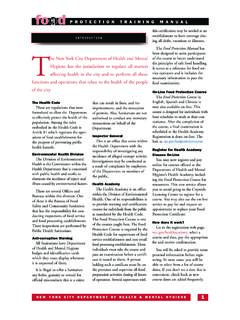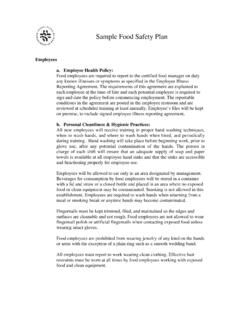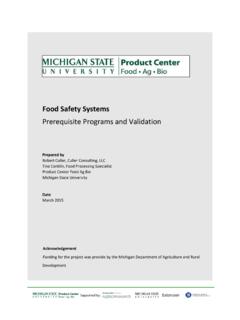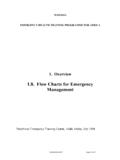Transcription of FOOD SAFETY MANAGER CERTIFICATION
1 food SAFETY MANAGER . CERTIFICATION . Study Guide How to study before the class and/or exam This study guide can be used to prepare for the food SAFETY MANAGER Exam. Here are some tips to help you review: As you review the study guide use the sections to help test yourself. Whenever you see the symbol, remember it's an important topic. food MANAGER USA. Chapter 1 - Providing Safe food A foodborne illness is a disease transmitted to people through food . An illness is considered an outbreak when: 1. Two or more people have the same symptoms after eating the same food 2. An investigation is conducted by state and local regulatory authorities 3.
2 The outbreak is confirmed by laboratory analysis Challenges include: Time and money, language and culture, literacy and education, pathogens, unapproved suppliers, high-risk customers and staff turnover. Costs of Foodborne illness Loss of customers and sales Lower staff morale Increased insurance Loss of reputation Lawsuits and legal fees premiums Negative work exposure Staff missing work Staff retraining There are 5 top risk factors for foodborne illness : 1. Purchasing food from unsafe sources. 2. Failing to cook food correctly. 3. Holding food at incorrect temperatures. 4. Using contaminated equipment.
3 5. Practicing poor personal hygiene. Q. How Does food Become Unsafe? 1. Time-Temperature Abuse 2. Cross Contamination 3. Poor Personal Hygiene 4. Poor cleaning and sanitizing Foods Most Likely to Become Unsafe The food & Drug Administration calls these foods, TCS foods. They consist of: Dairy products, eggs, meats, poultry, fish, shellfish, cooked potatoes, cooked rice, soy and soy products, bean sprouts, cut tomatoes and melons & garlic and oil mixtures. Q. What is Ready-to-Eat food ? A. Ready-to-eat food is food that can be eaten without further: Preparation Washing Cooking Ready-to-eat food includes: Cooked food , Washed fruit and vegetables, Deli meat, Bakery items and Sugar, spices, and seasonings Some Populations are at a High Risk for Foodborne Illnesses: Elderly people, preschool-age children, and people with compromised immune systems 1.
4 How Foodborne Illnesses Occur - Unsafe food is the result of these 3 contaminations: Biological Contaminants Chemical Contaminants Physical Contaminants Bacteria Cleaners Metal shavings Viruses Sanitizers Staples Parasites Polishes Bandages Fungi Glass Dirt Natural Objects (fish bones). Contaminants come from a variety of places: Animals we use for food Air, contaminated water, and dirt People Deliberately or Accidentally People can contaminate food when: They don't wash their hands after using the restroom They are in contact with a person who is sick They sneeze or vomit onto food or food contact surfaces They touch dirty food -contact surfaces and equipment and then touch food 2.
5 Chapter 2 - Forms of Contamination Biological Contaminants Remember These Terms . Microorganism: Small, living organism that can be seen only with a microscope Pathogen: Harmful microorganism and makes people sick when eaten or produce toxins that cause illness Toxin: Poison Common symptoms of foodborne illness : Diarrhea, Vomiting, Fever, Nausea, Abdominal cramps, Jaundice (yellowing of skin and eyes). Onset times: Depend on the type of foodborne illness can range from 30 minutes to six weeks Q. What 4 types of pathogens can contaminate food and cause foodborne illness ? A. Bacteria, Viruses, Parasites & Fungi BACTERIA.
6 Location: Found almost everywhere Detection: Cannot be seen, smelled, or tasted Growth: Will grow rapidly if FAT TOM conditions are correct (see page 3). Prevention: Control time and temperature Use FATTOM to help you remember the conditions in which bacteria grows rapidly food - Most bacteria need nutrients to survive; TCS food supports the growth of bacteria better than other types of food Acidity - Bacteria grow best in food that contains little or no acid; what Bacteria Need to Grow Temperature - Bacteria grow rapidly between 41 F and 135 F (5 C and 57 C; temperature danger zone Time Bacteria needs time to grow Oxygen - Some bacteria need oxygen to grow, while others grow when oxygen isn't there Moisture - Bacteria grow well in food with high levels of moisture Control FAT TOM - The conditions you can control: Temperature - Keep TCS food out of the temperature danger zone Time - Limit how long TCS food spends in the temperature danger zone Major Bacteria That Cause Foodborne illness The FDA has identified four types of bacteria that cause severe illness and are highly contagious.)
7 Bacteria Source Linked food Prevention Method Salmonella Typhi People Ready to eat food Wash Hands Beverages Cooking food to min. temp. Shigella spp. Human Feces Hands touching Exclude food handlers with TCS foods diarrhea Produce Control flies Escherichia coli (E-coli) Intestines of cattle Ground beef Exclude food handlers with Produce diarrhea Prevent cross contamination Nontyphoidal Salmonella Farm Animals, People Poultry & Eggs Cook poultry & eggs to Dairy products minimum temperatures Produce Prevent cross-contamination Exclude foodhandlers who are vomiting or have diarrhea 3. VIRUSES.
8 Location: Carried by human beings and animals, require a living host to grow, do not grow in food and can be transferred through food and remain infectious in food . Sources: food , water, or any contaminated surface and typically occur through fecal-oral routes Destruction: Not destroyed by normal cooking temperatures, good personal hygiene must be practiced when handling food and food -contact surfaces, quick removal and cleanup of vomit is important. Major Viruses that Cause Foodborne Illnesses Viruses Source Linked food Prevention Method Hepatitis A Human Feces Ready to eat Exclude staff with Hep.
9 A. food and/or jaundice Shellfish Wash hands Buy shellfish from reputable supplier Norovirus Human Feces Ready to eat Exclude staff with food Norovirus and/or Shellfish vomiting or diarrhea Wash hands Buy shellfish from reputable PARASITES. Location: Require a host to live and reproduce Source: Seafood, wild game, and food processed with contaminated water, such as produce Prevention: Purchase food from approved, reputable suppliers, cook food to required minimum internal temperatures and fish that will be served raw or undercooked, must be frozen correctly by the manufacturer. FUNGI. Location: Yeasts, molds, and mushrooms.
10 Some molds and mushrooms produce toxins, throw out moldy food , unless mold is a natural part of the food , purchase mushrooms from approved, reputable suppliers. Biological Toxins: Naturally occur in certain plants, mushrooms, and seafood Seafood toxins: Produced by pathogens found on certain fish (Tuna, bonito, mahi-mahi). Histamine produced when fish is time-temperature abused. Occurs in certain fish that eat smaller fish that have consumed the toxin. Barracuda, snapper, grouper, amberjack Ciguatera toxin. illness : Symptoms and onset times vary with illness . People will experience illness within minutes General symptoms: Diarrhea or vomiting, neurological symptoms, tingling in extremities, reversal of hot and cold sensations, flushing of the face and/or hives, difficulty breathing and heart palpitations.







